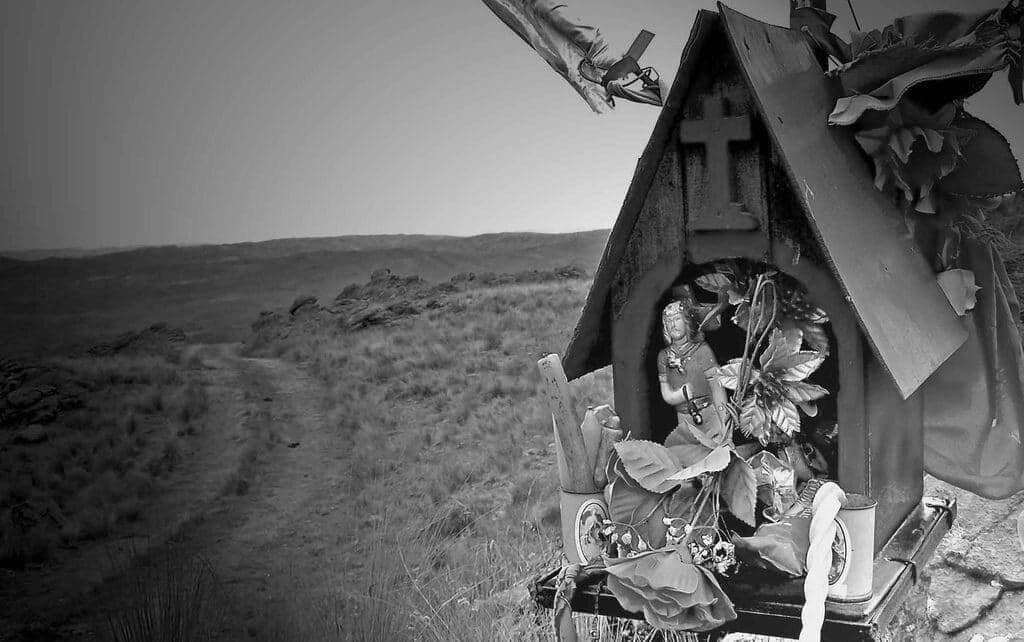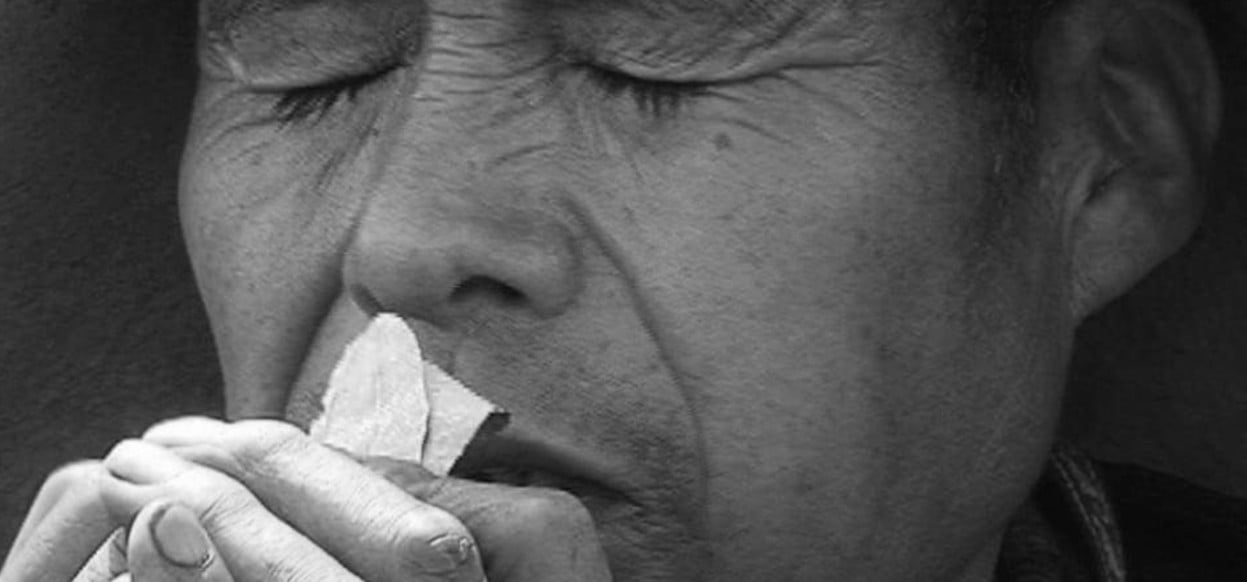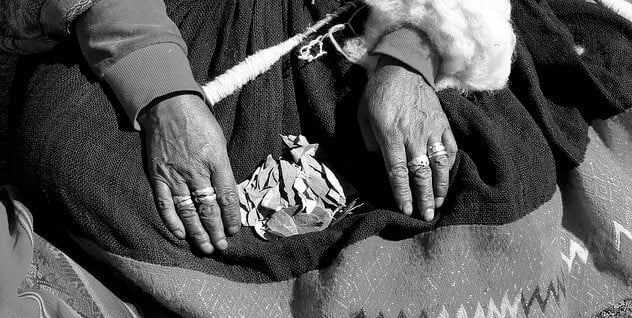Along roadsides throughout Argentina we notice mystical shrines with red flags flying around them. Discover the folk saint Gauchito Gil. We hitchhiked in Oman, China, Malaysia, the islands of Indonesia; across Europe and up and down the coastlines of South America; it was smelly, exhausting, uncomfortably awkward and highly rewarding.
In this Article
A prayer to Gauchito Gil
Viajar a dedo – Thumbing rides in Argentina and Chile can mean days in a variety of miserable conditions, from icy Patagonian wind, to dry Pampa heat. And we had both. Until that sudden thrill of a truck slowing down and the fumbling moment when we gather our belongings and sprint towards an open door.
We stood at the right place, the lorry did not only stop on the Ruta Nacional to Ushuaia because of us, Jorge Valdez, our trucker friend wanted to stop at a little road shrine next to us. He invited us to have a mate with him next to Gauchito Gills shrine. Jorges says a prayer:
OH! Gauchito Gil Te pido humildemente Se cumpla por intermedio Ante Dios, el milagro que te pido: [la petición] Y te prometo que cumpliré Mi promesa y ante Dios Te haré ver, Y te brindaré mi fiel agradecimiento Y demostración de Fe En Dios y en vos Gauchito Gil Amén
OH! Gauchito Gil
I humbly ask you
It is fulfilled through Before God,
I ask you,
a miracle:
[the request]
And I promise you to meet
My promise and before God
I'll make you see
And I will give you my faithful thanks
And demonstration of faith
In God and in you Gauchito Gil
Amen
“Inclement weather, blind corners, and steep drop-offs can make driving this road a harrowing and dangerous experience”
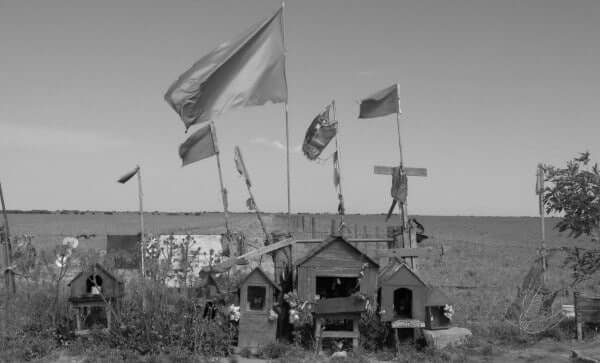
“This particular shrine is located where the mountainous route connects to the safety of the valley floor. We truck drivers stop here to give thanks to Gauchito Gil for safe passage through the Andes.” “What do people ask Gauchito for?”
“ Oh, there are many requests: health, money, work, love, courage and fundamentally protection of travelers.”
We leave a prayer for travelers, all of them.
Little red altars lining the roads outside villages all over Argentina are actually shrines built in honor of Gauchito Gil. Surrounded by bright red flags, ribbons and sails, they are easy to spot. It is thought that the red flag represents Gil’s neck scarf soaked in blood after his execution.
Inside there is usually a statue of the gaucho or images representing him. Travelers stop to offer quilmes (beer), wine, cigarettes, red flowers or other objects to greet the memory of the folk saint.

ETYMOLOGY: Gaucho Gill
The word gaucho, defies easy definition because it encompasses an entire cultural tradition. The usual, ‘‘Argentine cowboy,’’ is a start, but it carries the entirely inappropriate baggage of what ‘‘cowboy’’ – as in ‘‘cowboys and Indians’’ – implies.
The Spanish term ‘‘gaucho’’ to denote men (the women are called chinas) or sometimes men and women collectively who belong to or who identify with the horse-riding, cattle-ranching traditions and life in the Argentinian pampa.
Gil, like most of the gaucho saints, was a bandolero (bandit). These outlaws roamed in bands on the fringes of society, always hiding from the law. They made their living on the run by rustling cattle and robbing landowners. Gil and other bandit leaders were legendary – strong, brave, handsome, noble, bold, charismatic – and they were revered for their heroic attributes by their followers and the public alike. Only the privileged class despised them.
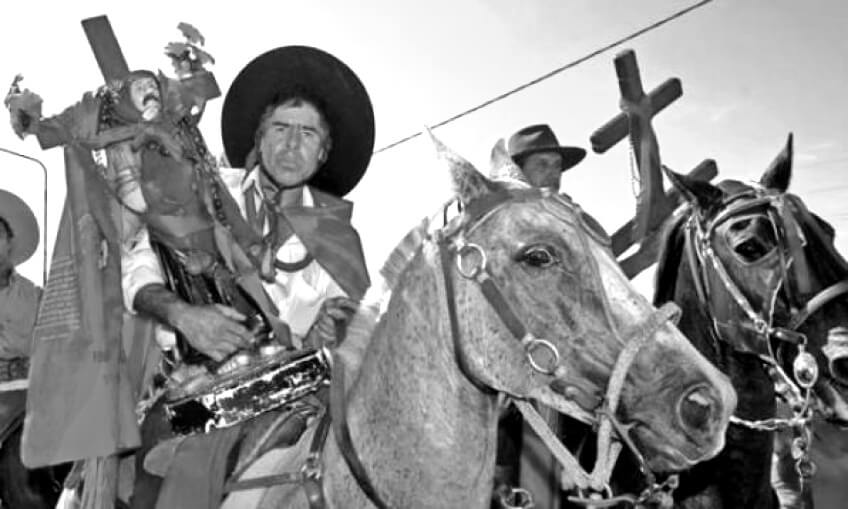
Antonio Mamerto Gil Núñez
Like many folk saints, little is known about the historical Gaucho Gil. Other possible names are Antonio Gil o Curuzú Cruz Gil.
His real name was probably Antonio Mamerto Gil Núñez, and he was most likely born in the 1840s in the province of Corrientes and executed by the government of Argentina on the 8th January 1878, and became an enduring legend.
Till today this folk saint is not recognized as a “saint” by the church.
LEGEND: Gaucho Gil
Civil war was raging in the region, and around 1875, Gil was forcibly recruited by Colonel Juan de la Cruz Zalazar into a gaucho militia (Guerra de la Triple Alianza ,1864-1870, against Paraguay). Gil deserted shortly after because he was unwilling to kill his fellow gauchos.
Some say that an angel had advised the desertion during a vision, or that the Guaranı́ god Ñandeyara (Christianized, with the requisite white beard and luminescent aura) appeared to Gil in a dream.
Afterward, Gil lived by necessity outside the law, on the run, stealing from the rich to give to the poor and always evading the authorities. He was handsome, noble, and invincible, and his penetrating gaze was hypnotic.
On January 6, possibly in 1878, Gil was attending a party for the feast of St. Baltasar. He was betrayed by a friend and captured. He surrendered peacefully, without any resistance. A police escort was ordered to transport him to Goya for sentencing, but en route, just outside of Mercedes, the sergeant in charge decided to execute Gil. This was done under the pretext of an attempted escape.
Gil was hung upside down from an espinillo tree and his head was cut off with his own knife, which he offered for this purpose.
‘‘This is an injustice,’’
Gil told the sergeant just before the execution.
‘‘You are spilling innocent blood.’’
Gil also said that the sergeant’s son was gravely ill but that Gil would intercede in heaven to save the boy’s life. When the police arrived in Goya, they discovered that Gil had been pardoned and would have been freed had they not executed him.
The sergeant went home to find, as Gil had prophesied, that his son was on the verge of death. He implored Gil’s help and forgiveness, the miracle was granted, and the moribund son recovered.
In gratitude, the sergeant returned to the site of the execution, and in the ground reddened with Gil’s blood, he erected a cross made of ñandubay wood. Thus began the devotion. The cross gave the crossroads its name, and over time it became a place of pilgrimage.

Another version ends the tale with the words:
They say that his last words were
‘‘The blood of an innocent will save another innocent.’’
Another version recounts that Gil was a cuatrero (cattle rustler) who was with the poor. Recruited to combat in the war of the Triple Alliance, he deserted and was persecuted. When he was captured because of the crimes he committed, a commissioner was about to shoot him under a tree, and Gauchito Gil said:
‘‘Do not kill me, that the letter of my innocence is going to arrive.’’
The commissioner replied: “You are not going to save yourself, and the Gauchito said:
“When the letter comes you will receive the news that your child is dying because of a disease;
your son is going to be saved if you pray to me I will safe him, but today you will be shedding the blood of an innocent.“
At that time it was believed that, invoking the blood of an innocent was miraculous. Upon arriving at his house in Mercedes, the commissioner found his sick son, prayed for him on behalf of Gauchito Gil and his son was healed. The commissioner returned to where Gauchito Gil’s body was and gave him burial.
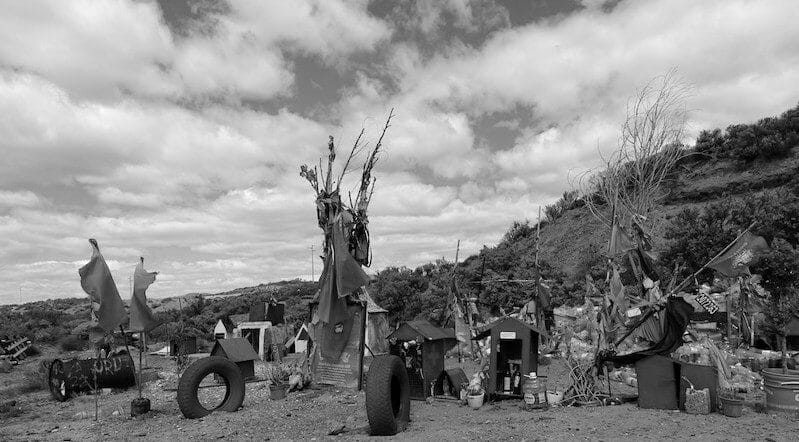
A more political version goes:
Gauchito Gil directed a group of autonomist thugs who went from town to town looting, stealing the rich (to give it to the poor) and killing every liberal to cross their way. He was devoted to Santa La Muerte and said he was impossible to kill. He was captured by a group of men from the liberal party and slaughtered near Mercedes, Corrientes.
Regarding the way of his death there are at least three versions:
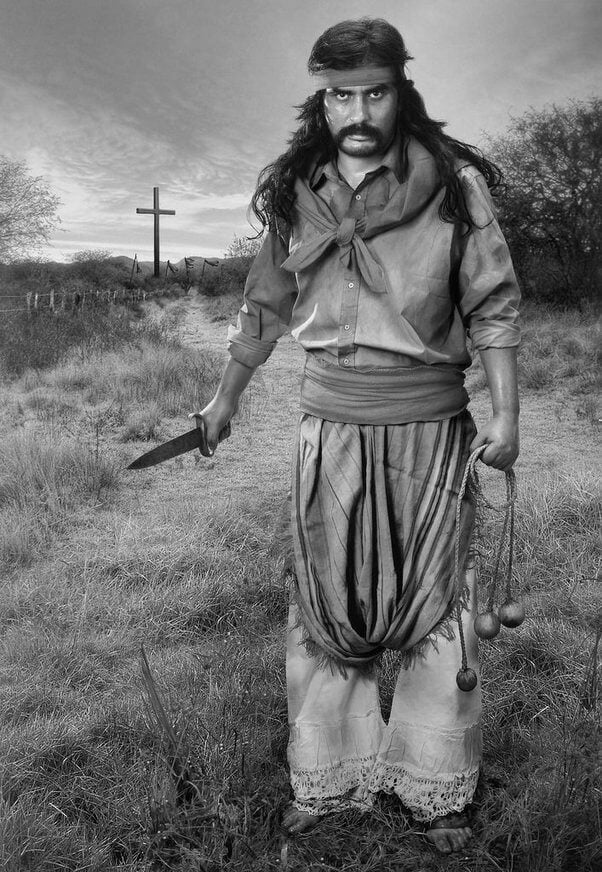
- They tied him on a tree and shot him with firearms, but none of those bullets entered the body. Popular belief says that who carries the amulet of San La Muerte is invulnerable to bullets. Gauchito was a devotee of the “Santito”. Then the sergeant ordered that he hang on his feet and there he slaughtered him.
- He died after several attempts till a bullet finally entered his heart.
- He was hung from an espinillo tree, head down and then beheaded, because he had the power to hypnotize people “just by looking them in the eye.”
The story of gaucho sainthood is as political as it is religious. A rebellious figure, often a civil war deserter, is forced to the margins of society and survives through his courage and ingenuity.
He commits crimes of necessity rather than greed, and he is welcomed as a benefactor among impoverished people who harbor or help him. He obeys a higher moral standard, kills only in self-defense or just revenge, protects and cares for the poor, inspires locals with his feats, and, although clearly the underdog, outnumbered and outgunned, he evades and mocks his people’s feared oppressors.
When the gaucho is finally apprehended, often as a result of betrayal, he becomes the victim of a gruesome execution. His death is always perceived as the authorities’ unjust abuse of power. Out of this injustice, the gaucho saint is born.
ICONOGRAPHY: Gaucho Gil

All over Argentina, his small shrines can be found along roadsides. They are often ramshackle, little more than a crate containing a statue. Sometimes they are painted red or festooned with red ribbons and cloth.
At the center of many of these shrines stands a statue of a man with a black mustache, long black hair, a red handkerchief around his neck, wearing white pants and a blue shirt. At his back is a cross, often red. In his hands he holds bolas, which are throwing weapons made of leather or rope connected to as many balls as there are straps.
Bolas were the traditional weapons of the Argentinian gauchos, or cowboys, who used them to tangle the legs of steers or capture and kill prey animals.
Offerings:
There were a variety of “offerings” inside the small shacks we saw, including, cans of beer, bottles of wine, small statues of Gauchito Gil, cigarettes and lighters. Jorge knows;
“people take all kinds of offerings, bronze plates, family photos, house models, car and motorbike parts, there are those who bring beer or wine bottles, cigarettes, statuettes and yerba [mate] packages and even clothes.”
Red candles are lit also.

The color red and Gauchito Gil
The color red has many meanings. For some devotees it represents blood and sacrifice, specifically Gil’s spilled blood. Also suggestive, but not mentioned by Jorge, are the broader uses of the color red for luck and protection.
In Buenos Aires, for example, many people put red ribbons on the rear view mirror of their car to protect them from envy. The red-ribbon bracelets that are tied on babies’ wrists in many parts of Latin America serve the similar function of warding off the evil eye of envious onlookers.
The red ribbons with the name of Gaucho Gil are also a request for protection for the owner, they hang from the mirrors of cars and are tied in visible places in the stores. On crossroads, the red ribbons are tied to the branch of a tree or a stick, stuck in the ground. They are places of stop for every traveler and devotee. Buses and walkers stop for a moment to greet Gauchito.
In the province of Formosa, where there are shrines, drivers honk as they pass. If this were not done, he would not have the saint’s protection for the rest of the journey and misfortune could ensue.

More critical to Gaucho Gil devotion is the political affiliation designated by the color red. The color-coded struggle between the Federales (red) and the Unitarios (blue) during the nineteenth century was repeated in Corrientes Province by the corresponding parties, the Autonomistas (red) and the Liberales (blue).
The Autonomistas were more traditional and associated with the lower classes, while the Liberales were more progressive and elitist. Because red is the color of Gaucho Gil devotion, many people presume that Gil belonged to the Autonomist party, which seems logical given his social class and rural values. The same is said of gaucho saints Francisco López, Gaucho Lega, and Aparicio Altamirano, all of whose devotions are associated with the color red.
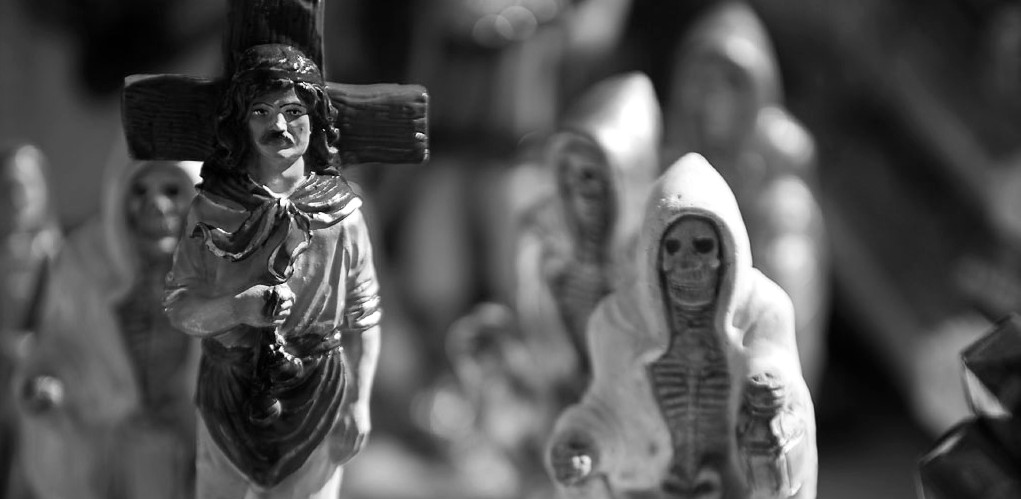
CC -BY-SA 2.0., edited.
More likely, however, is that Gaucho Gil was among the troops of the Liberal party (blue). Some say that blue flags originally sew at the shrine, and later – according to several press reports from the early 1970s – red and blue flags flew together.
If one can superimpose the myth on the landscape, then this flying of red and blue flags together suggests a symbolic reconciliation of the warring parties. Gil refused to kill fellow gauchos divided arbitrarily by political struggles, and thus his shrine with two flags stands as a kind of demilitarized zone.
The political factions make their peace so that the rural poor can unite in solidarity. The same is suggested by the standardized Gaucho Gil iconography, which has Gil in a blue shirt with a red bandana and red headband.
Gauchito Gil and San la Muerte share shrines
At Gaucho Gil shrines another folk saint is also present, it is San La Muerte (Saint Death), mainly represented as a caped male skeleton with a scythe, he is also called Santito (Little Saint, owing to the tiny amulet), San Esqueleto (Saint Skeleton, used primarily in Paraguay) and Señor de la Buena Muerte (Lord of Good Death).
As a seated, crowned, skeletal figure holding the head between his hands he is also called San Justo (the Just Saint, or Saint Justice), San Bernardo or San Paciencia. The former representation is most common in the area of Buenos Aires.
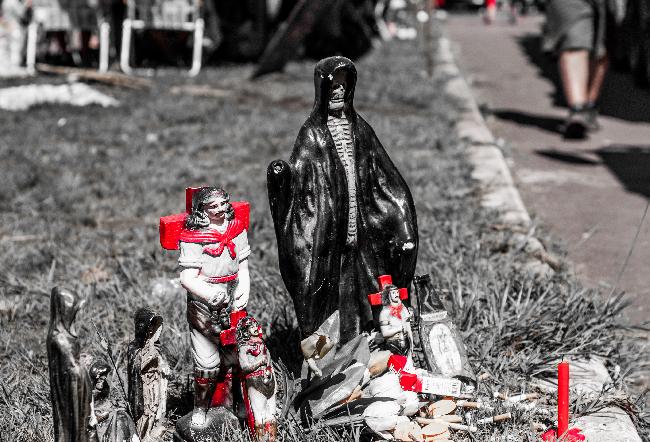
San La Muerte is not Santa Muerte (Most Holy Death or Santı́ssima Muerte) in Mexico, the latter – a variation of the Virgin Mary – has an entirely different identity.
San la Muerte is perceived as absolute justice because of a powerful association: nobody can escape death. His amulet was used to injure or kill one’s enemies. The saint and the amulet today are used by most devotees to request the usual miracles concerning health, work, love, and family. The power of death is thereby redirected and deployed to positive ends: death is transformed into a protector of life.

The devotion, besides being practiced alongside Catholic faith, can incorporate or be associated with other folk saints, some non-canonic, such as the devotion for El Gauchito Gil or Difunta Correa and others belonging to the Catholic Church, most notably in the Maria Devotion (Virgen Desatanudos, Virgen de la Medalla Milagrosa, Virgen de Luján) but not exclusively: San Cayetano, San Roque, San Antonio, Santa Rita, and Santa Bárbara.
Such incorporation can be visual and material: when effigies of the saints are placed side by side in the same altar. Or as well as narrative and theological; when tales of San La Muerte are related to the gospels or to stories regarding other saints, like with Gauchito Gil.
Legend has it, that Gauchito Gil was devoted to San La Muerte who made him invulnerable.
The protective power of death extends into the belief that San La Muerte makes one invulnerable to lethal weapons. This use of the amulet is particularly prevalent among criminals, police, and – much less now than in the past – gauchos prone to knife duels. A 1917 book on folklore in Misiones typically described
San La Muerte
as ‘‘excellent against bullets and knives.’’
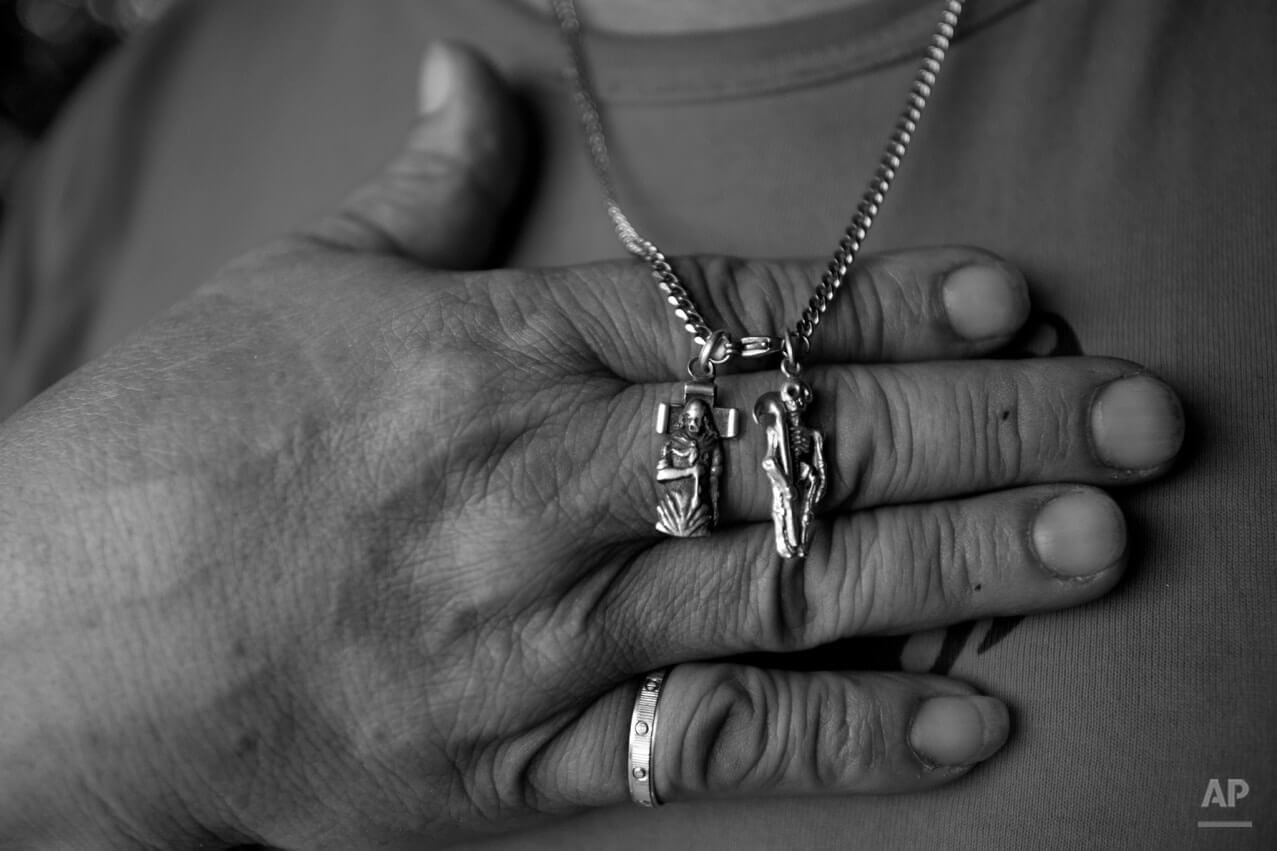
The shrines
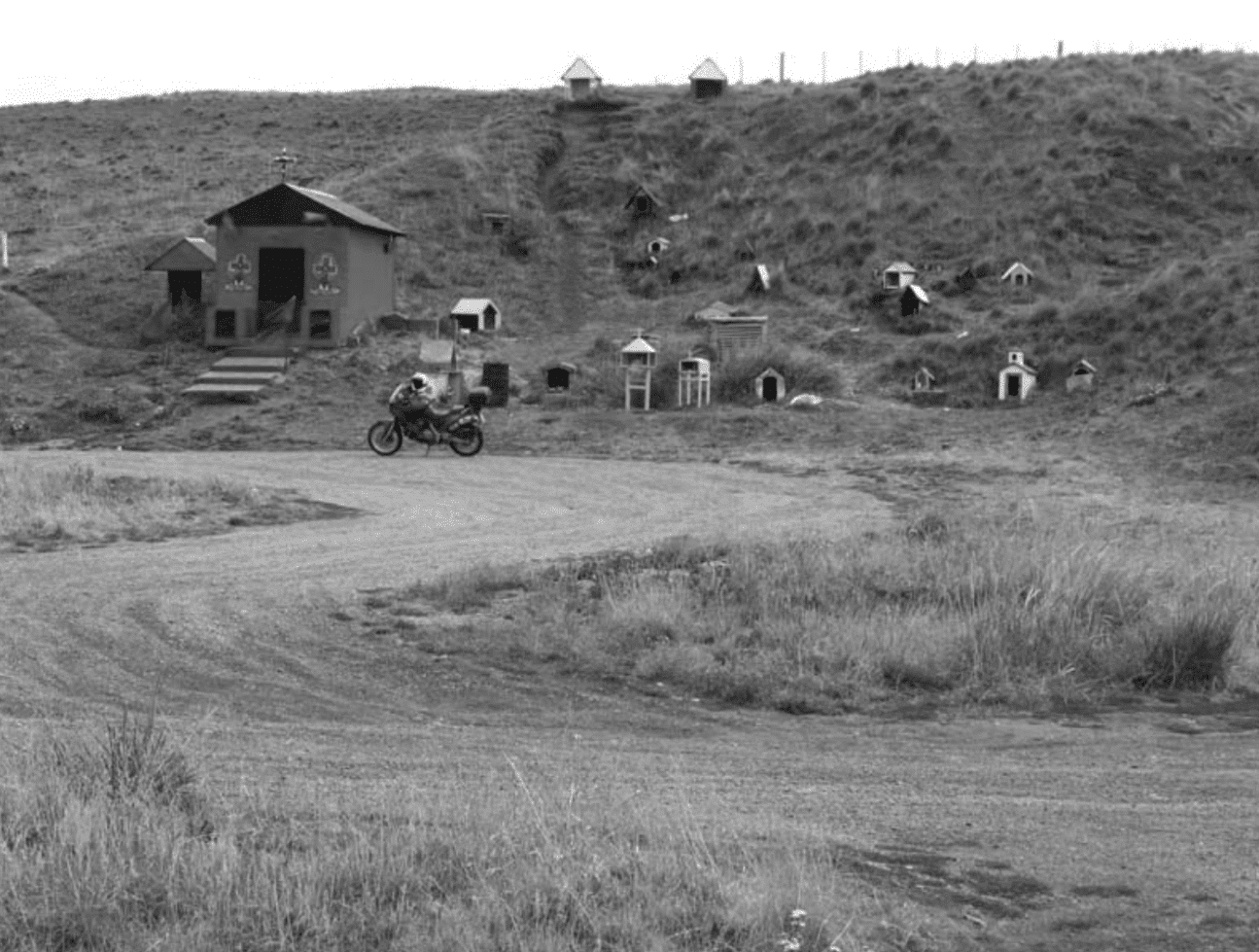
The highways of Argentina, from one end of the country to the other, but particularly in the north, are spotted with roadside shrines to Gaucho Gil. The shrines come in all shapes and sizes but are easily identified by their red flags and altars.
With the exception of the larger, more tourist-oriented shrines (there is one not far from the principal shrine in Mercedes, and another near the Difunta Correa shrine in San Juan).
There are also innumerable domestic altars and shrines to Gaucho Gil, many of which are open to the public. These are frequented by devotees and promote the growth of the cult throughout Argentina. Some of these domestic shrines evolve into satellite centers gradually filled with offerings.

The Tree of Faith
In the Puente de la Noria neighborhood of Buenos Aires, a shrine emerged in 1999 after Gaucho Gil appeared in a tree. A huge cement cross and statue of Gaucho Gil were donated by a devotee, and in November 2001, the image of Gaucho Gil made a second appearance, now in the cement on the back of the cross.
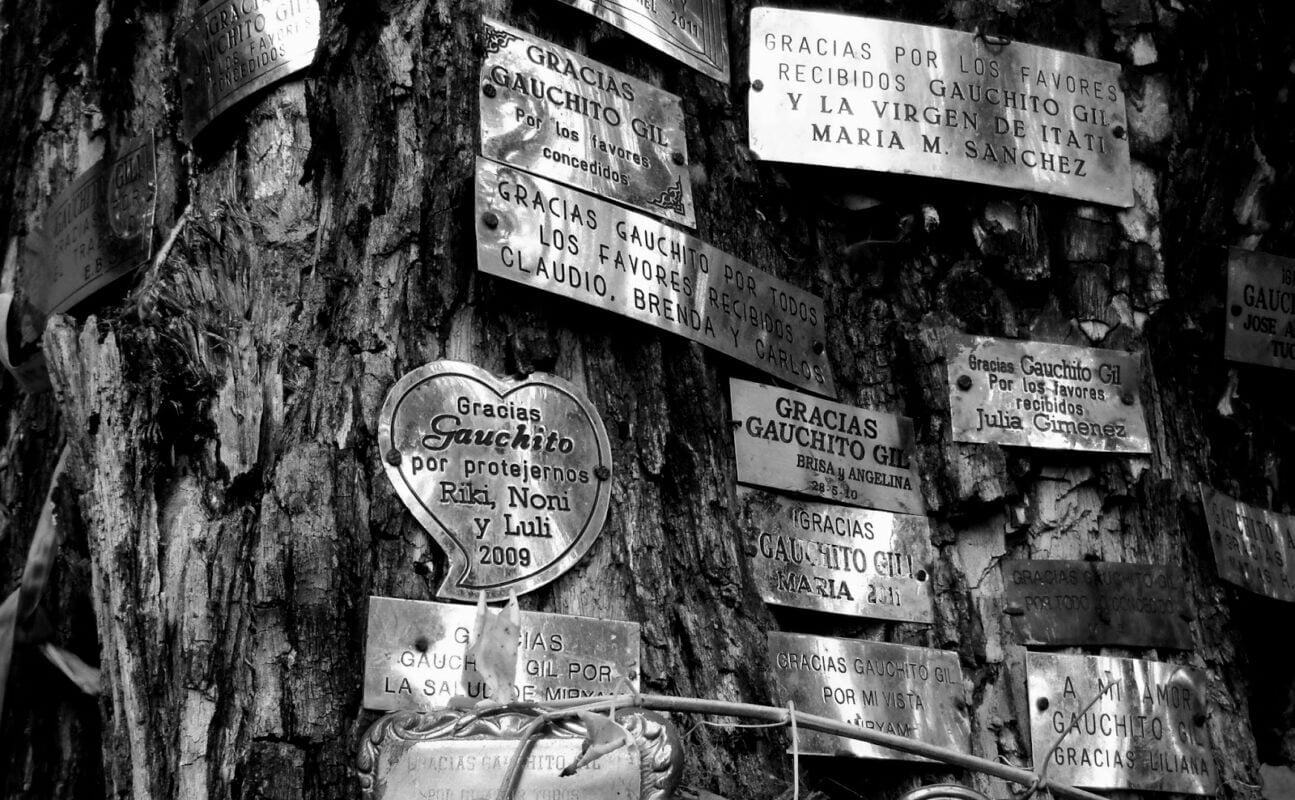
Today this Buenos Aires site, known as the Tree of Faith, is a well-organized complex, with many side altars, innumerable offerings of every sort, and a courtyard lined with vendor stands selling devotional paraphernalia.
Advocates of the site – the vendors – explained that the bones of Gaucho Gil may be in Mercedes, but the Tree of Faith is the only site where Gil’s image has appeared, and twice. They envision this shrine as a major center of Gaucho Gil devotion, and, owing in part to the many migrants from Corrientes to Buenos Aires, it appears to be well on its way.
All of these regional chapels recognize their secondary status to the principal shrine, and to a certain degree they serve as stations of convenience for devotees who wish to petition miracles or fulfill promises without making the pilgrimage to Mercedes.
Gauchito Gils sanctuary in Mercedes
Antonio Mamerto Gil Núñez, known as Gaucho Gil, is without a doubt the most prominent of the many gaucho folk saints in Argentina. His principal shrine, at the site of his death just outside the town of Mercedes in Corrientes Province, attracts hundreds of thousands of devotees. This pilgrims heading to the sanctuary do ask the saint for favors or thank for the fulfillment.

Legends about Gauchito Gils sanctuary
Two stories are told about the place where the shrine was built and Gauchito’s desire to continue staying there:
Over the years, there were so many devotees that would visit the saint and light candles, that the owner of the site was afraid that the field would burn down and took the body to the local cemetery. It is said, that this farmer was a wealthy man with a healthy and well-established family. But from the moment he decided to move the oratory away, he began to have economic problems, one of his sons died of a strange disease, the farm animals became sick and the fields were drying up. He fell into bed and the doctors could not help. One day, a woman who was called to heal him said that he would get better if he would bring the Gaucho back to his place.
The farmer built a mausoleum along with a cross carved from fine wood on the spot where Gauchito Gil died. From now on, everything improved for the owner of the field. The gaucho remained buried in the local cemetery, but his place of death became a cult center.

Some surprising facts began to happen when the route was paved and the engineers decided that the most practical thing was to draw a straight line to shorten distances, even if it passed through the Gauchito oratory and therefore it was necessary to move it.
The workers said that “It was not good to build on sacred lands of the Correntinos”, but the businessmen ignored this warning. Many employees refused to comply with the order and resigned. When they were close to the area in question, the machines refused to move forward, neither the drivers, mechanics nor the bosses were able to put them into operation. Workers started to desert because they thought it was all the work of the gaucho who refused to be removed from that place. Faced with so many difficulties, they decide to respect the sanctuary and build the road around Gauchito Gil’s sanctuary.
The Oratory is thus respected and the engineers ask for forgiveness and protection for their work.
FESTIVAL: La fiesta de Gauchito Gil
The walls of Gaucho Gil’s shrine in Mercedes are covered with some fifty thousand plaques giving thanks for miracles. The site is frequented throughout the year, but on and around the day of the fiesta, January 8, it is transformed into a carnival of devotion. Locals arrive by car and on foot, bicycle, and horseback. Others come by the carload and busload from afar and from abroad – Paraguay, Uruguay, Brazil, Chile, and even the United States and Europe. The total attendance at the fiestas is well in excess of a two hundred thousand people. Buses and cars line the highway for miles in each direction.
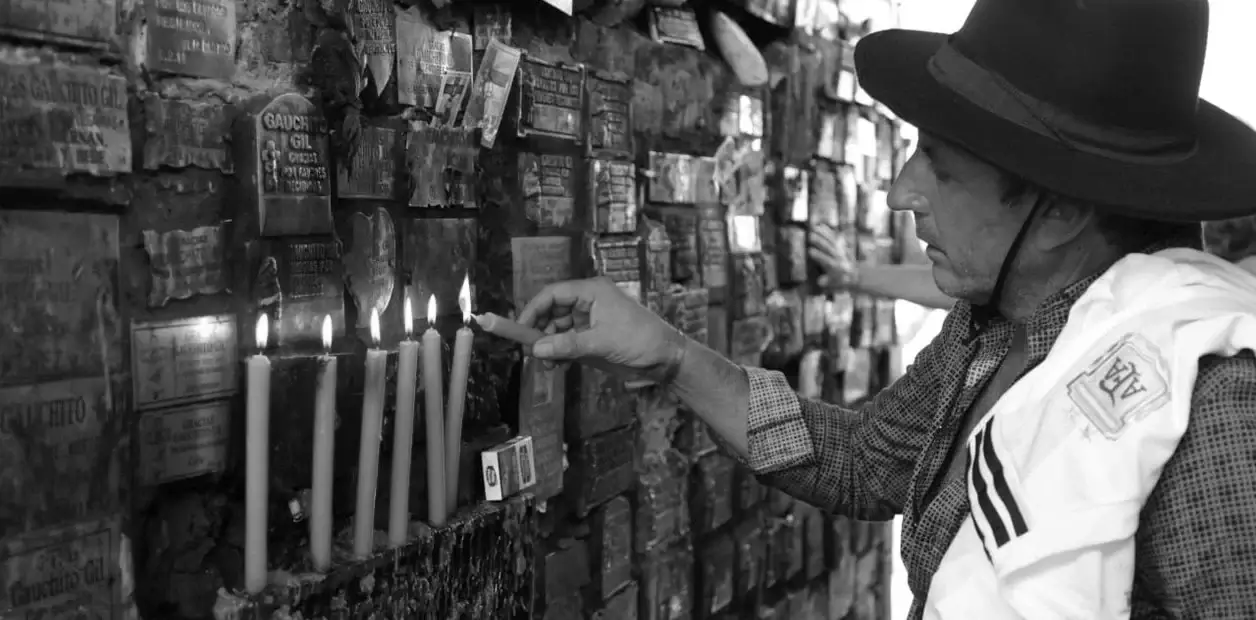
Conspicuous upon approach to the Gaucho Gil shrine is the flash and furry of color from the flags, banners, ribbons, and clothes that boast the bright red associated with this devotion. A swarming movement of devotees converges upon the tomb, some dressed in full gaucho regalia. Hundreds of candles are burning. Vendors hawk religious images, food, souvenirs, and boot-legged brand-name anything. The whole conglomeration is held together by the heat. Boom boxes compete with live chamamé (dances); asado smoke intermingles with clouds of grease rising from fried empanadas; and the smell of rain, then the rain itself, cleanses the stench of camped-out humans and overrun, improvised bathrooms. Everyone is happy.
Devotion is the centerpiece, but the fiesta is also a festival of food and drink, of fun with old and new friends. Here, once a year, devotees escape from the dreary toil of economic survival to recharge their will, their joy, and their hope.
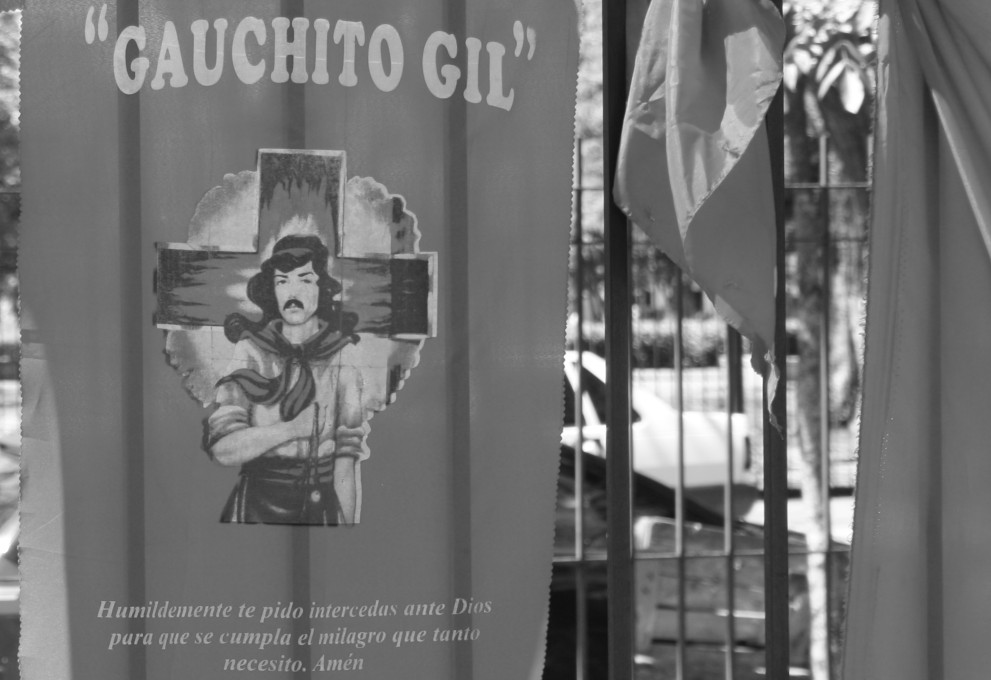
The church and Gauchito Gil
The principal shrine in Mercedes has enjoyed relatively peaceable relations with the Catholic Church. Our Lady of Mercy, the parish church, cautiously participates in the annual fiesta by celebrating a mass for Gaucho Gil’s soul.

The site of Gaucho Gil’s shrine was originally know as la Cruz de Gil, la Cruz Gil, or, in Guaranı́, Curuzú Gil (Gil’s Cross or, literally, Gil Cross). Many devotees still refer to it by these names today. ‘‘Gil Cross’’ is frequently used for the site name and as Cruz Gil, to refer to Gaucho Gil himself.
The cross from the Gaucho Gil shrine is brought to the church, mass is said in the early morning, and afterward a spectacular procession, known as the caravana, returns the newly blessed cross to the shrine. As the caravan departs from the church, the gauchos on horseback who take the lead are joined by a growing contingent of pedestrians, bicycles, and cars, all displaying red flags.
The caravan establishes a symbolic link between the shrine and the Church, a reminder that the devotees are Catholic, but the fiesta begins in earnest, with chamamé dance and a feast, when the cross is re situated at the shrine.

Father Julián Zini
Despite the Church’s ambivalence and occasional objection to Gaucho Gil devotion, the growth of the cult is largely indebted to a priest, Father Julián Zini, who for many years was the parish priest of Mercedes. He believed that folk devotions are the expression of a profound faith integral to everyday life, and that they should be accepted, even celebrated, as they are gradually guided toward orthodox practices. As Zini puts it in the language of Vatican,
“the priest’s responsibility is to assume, purify, and complete the religious instincts of his people.”
Julián Zini was also a notable poet advised to pray both for the soul of Antonio Gil and for those of all the faithful departed; devotion is recommended to focus “On the cross of Our Lord Jesus Christ and not on the deceased”, and laments “the mixture of expressions of popular religiosity with manifestations of magic and superstition.”
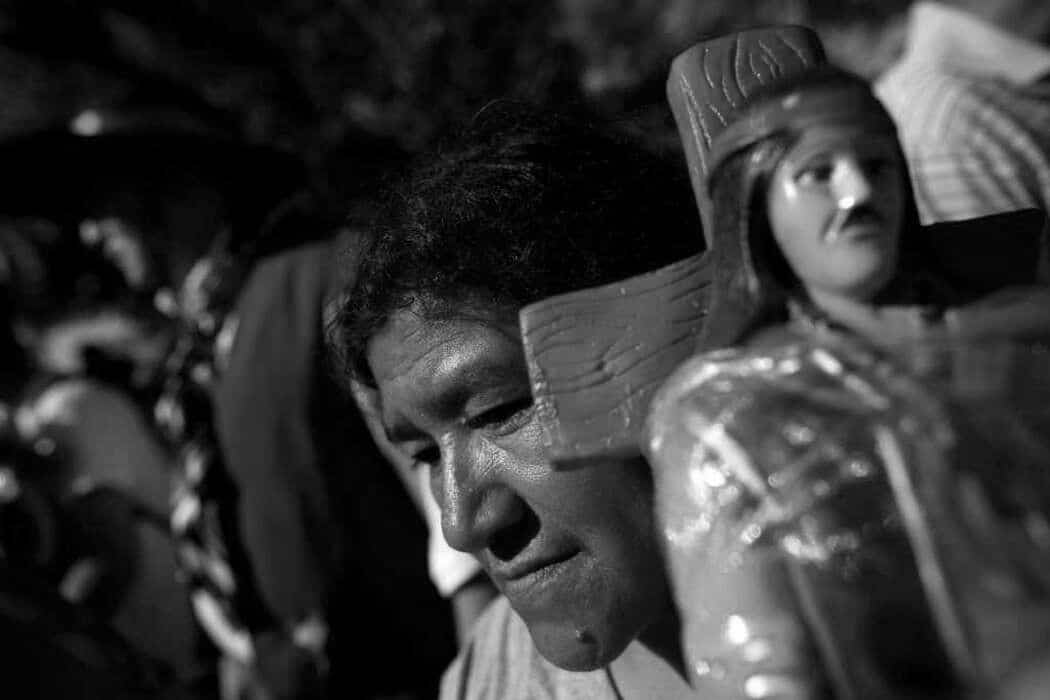
Father Zini is also the author of a poem that absolves Gauchito Gil of the transgressions of the law (robbery and desertion) that he starred in while he was alive and that triggered his death.
“If he stole, he stole from the rich
for popular justice,
The innocence of the poor
it’s called necessity! ”.
The priest praises the actions that led Gil to popular altars throughout Argentina, in a cult that has grown almost a century and a half after the fact that gave rise to his legend.
There are more poems in his honor such as the one written by Florencio Godoy Cruz and a chamamé with music by the composer Roberto Galarza entitled “Injusta Condena” – wrong sentence:
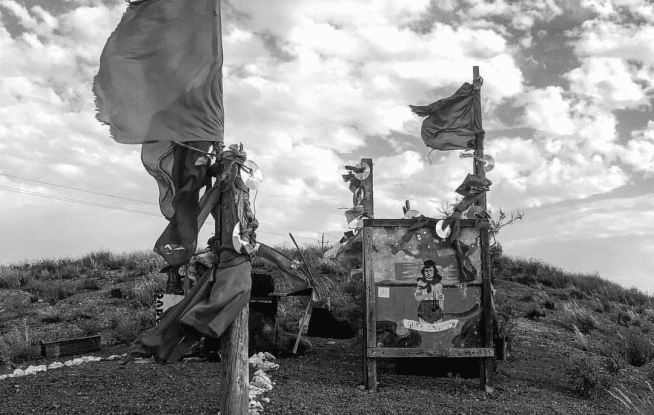
At that cross on the road of life and death, there was always a faithful guardian spine of his death. The wind rocked flags ... Antonio Gil, you considered yourself a noble gaucho with a good soul, your life was cut short by an unfair sentence.
“Will Gaucho Gil be a saint some day?” I ask Jorge, smiling he answers:
‘‘For us he is in fact a saint!’’
Whether Gaucho Gil is an official saint or not seems to matter little. For now, he remains extremely popular in Argentina – even more so than official Catholic saints. The evolution of devotion around him is evidence of this, and remains cause for fulfillment among the people who believe in his power.
Drive safe always Jorge Valdez, and thank you for sharing Gauchito Gil and Argentina’s culture and heritage with us. Oh, I forgot to mention that after sunset we saw a Puma crossing the road, but hey that is another story…

~ ○ ~
Keep exploring:
Works Cited & Multimedia Sources
- Barrios Cleo. Gauchito Gil: una devoción agigantada a la vera del camino. 2015.
- Bigliardi Stefano. The Argentinian San La Muerte and the Investigations of Walter Alberto Calzato. Foundation for Interreligious and Intercultural Research and Dialogue. 2015.
- Chesnut, R. Andrew. Devoted to Death: Santa Muerte, the Skeleton Saint. Oxford University Press. 2012.
- Euge Mariño. Antonio Mamerto Gil Nunez Gauchito Gil.
- Graziano Frank. Cultures of Devotion Folk Saints of Spanish America. 2007. THANK YOU.
- http://gauchitogil.org/
- http://www.graciasgauchitogil.com/
- https://www.cuco.com.ar/gauchito_gil.htm
- http://www.themontrealreview.com/2009/A-Regional-Christ-the-Folk-Saint-Gaucho-Gil.php
- https://webs.ucm.es/info/especulo/numero42/sanacion.html
- https://www.portaldasmissoes.com.br/noticias/view/id/3349/
- Maroney Eric. A regional Christ, the folk saint Gaucho Gil. The Montréal Review. 2012. https://www.themontrealreview.com/2009/A-Regional-Christ-the-Folk-Saint-Gaucho-Gil.php
